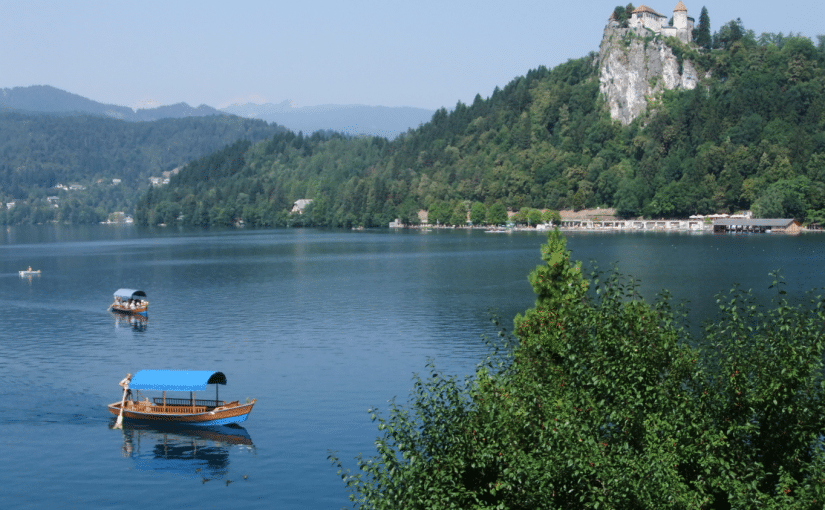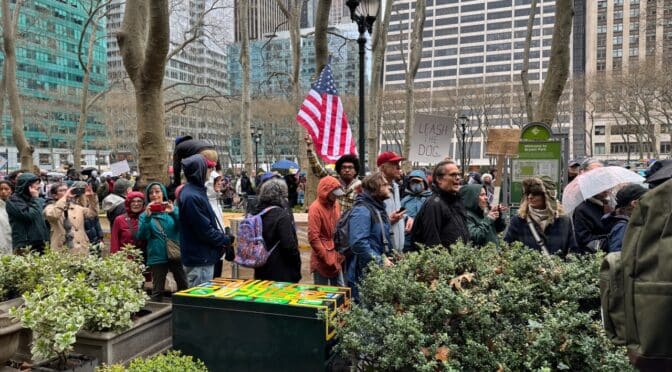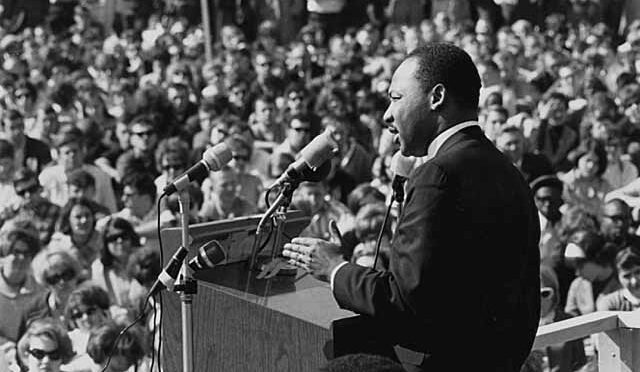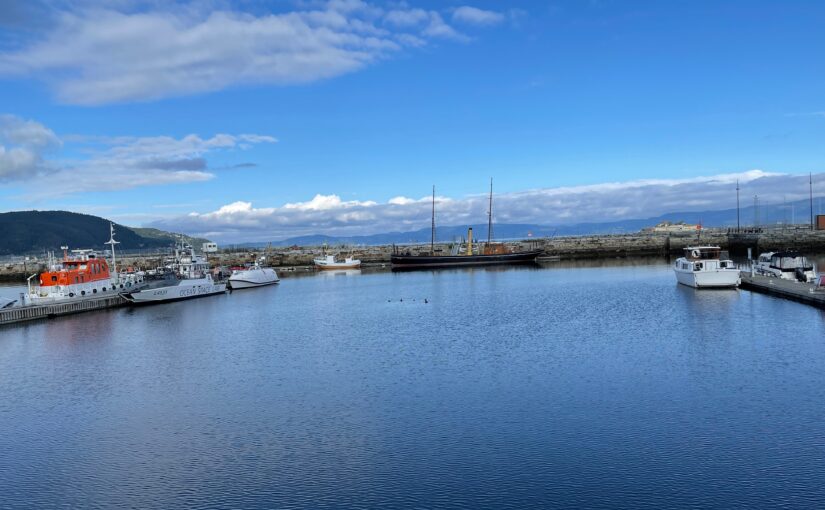Slovenia, Ljubljana and Bled
by Nick Taylor
The Balkans? What? Why? I thought it seemed odd when Barbara suggested taking a trip there. But our last few vacations have been, at least in part, about chasing history.

And the Balkans, the countries between Greece, Eastern Europe and the Adriatic Sea, are so known for fighting one another that “balkanize” means breaking something up into “smaller and often hostile units.” As a result, I would add, of religious hatreds leading to power and land grabs.
[caption id="attachment_41699" align="aligncenter" width="293"]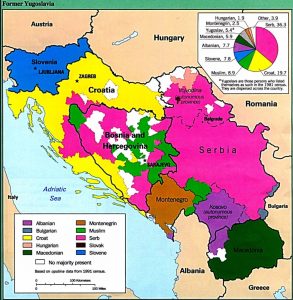 Courtesy Wikimedia
Courtesy Wikimedia
A nationalist assassin’s bullet fired in the Balkans started World War I and ended an empire. Fighting raged in Attila the Hun’s time, in Julius Caesar’s, during the reign of the Ottoman Turks, in World War II, in practically every period of history.
The old rivalries, released anew after the fall of Yugoslavia, exploded into the 1990’s Balkans war. Scars of the war still mar the landscape and the memories of the people who lived through it. Yet the ethnic and religious rivalries behind this tortured history exist in stunning beauty – footholds of green climbing mountains of stark rock, farmlands lush with olive groves and vineyards, and clear coastal waters where the mountains meet the sea. We decided we had to explore these contradictions for ourselves.
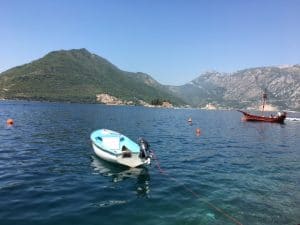
We mapped a route that would take us through Slovenia,
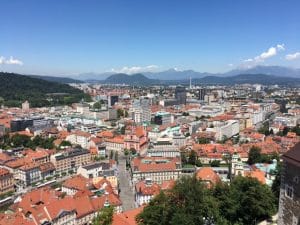
Croatia, Bosnia, Montenegro and then back to coastal Croatia. That would give us time to learn a little about the countries and then a chance for pure recreation, swimming and biking on an island in the Adriatic.
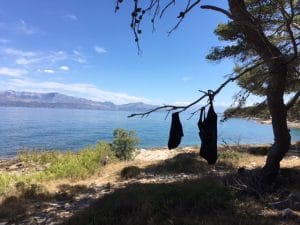
The best deal on business class flights put us on Swiss International Airlines into Zurich with a change to Venice. We ended up in first class, but that’s another story and you can read that here.
So we started on the ground at Marco Polo Airport in Venice where Karlo Soper, with GoOpti, picked us up in his van for the two-and-half hour ride to Slovenia’s capital, Ljubljana
Our fellow travelers were hostel-bound young Brits. They all piled into the back and we shared the front seat with Karlo. He spoke English and we started talking.
He told us his parents were teachers. He wasn’t interested in teaching so he studied business and then started a plastic fabrication shop that turned sheets of plastic into small storage containers. When he sold his business, he began driving and we, luckily, found he had a world of information and opinions to share.
Melania Trump came up first since we were headed toward her native Slovenia. “I’m not interested in Melania. She is living in a golden cage,” Karlo said dismissively.
He wanted to talk about geography and history. The highway east from Venice cut through farm and vineyard country, with the

Dolomites and Julian Alps on the northern horizon and the Adriatic Sea to the south.

The land has stories to tell, most of them bloody. Tribes of Greek Illyrians had the area to themselves until the Celts invaded in the 5th century BC. They gave way to the Romans under Julius Caesar in the 2nd century BC. By the 11th century AD the Roman Catholic Church held the region and became the ruling power. The mighty dukes of Venice displaced the church in 1420 and then ended up sharing power with the Hapsburgs. Napoleon ruled briefly in the early 19th century; he brought wine grapes to the region. By 1866, it folded in to the newly unified Italy.
A few miles into the area called Friuli-Venezia Guilia, Karlo began to talk about Italians in the same tone as he talked about Melania Trump.
He told us about fierce fighting during the first World War and the battle of Caporetto to the north – now Kobarid in Slovenia — that sealed Italy’s defeat.
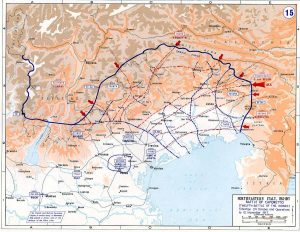
We’d later learn that many captured Italian soldiers were brought to Ljubljana’s castle prison. Karlo didn’t mention that.
But as we drove through Udine province, he waved his hand and said, “The Italians set up a camp here during World War II. Everyone forgets about that now.” Men who fought in the war talked about the Gonars camp, he said and the hardship suffered by Slovenes and Croats until Italy surrendered in 1943 and the camp was destroyed.
Despite our jet lag, the conversation drew us in. Unlike some of the other Balkan states, Slovenia remains pretty homogeneous. Like the rest of the former Yugoslavia, it was settled by South Slavs from the Caucauses who migrated into Europe in the 6th century. And then, despite the invaders and alignments and realignments, the Roman Catholic church got a firm hold on Slovenia in the 8th century and has remained a spiritual and political center.
“Look at all the churches,” Karlo said, pointing to the steeples poking above the small towns on the hillsides and in the valleys we passed. “They say we have so many churches because they used them to send signals when the Turks came. They came, but they never stayed.” He was referring to the 16th century Ottoman invasion, and why Islam never took hold here.
[caption width="319" align="alignnone"]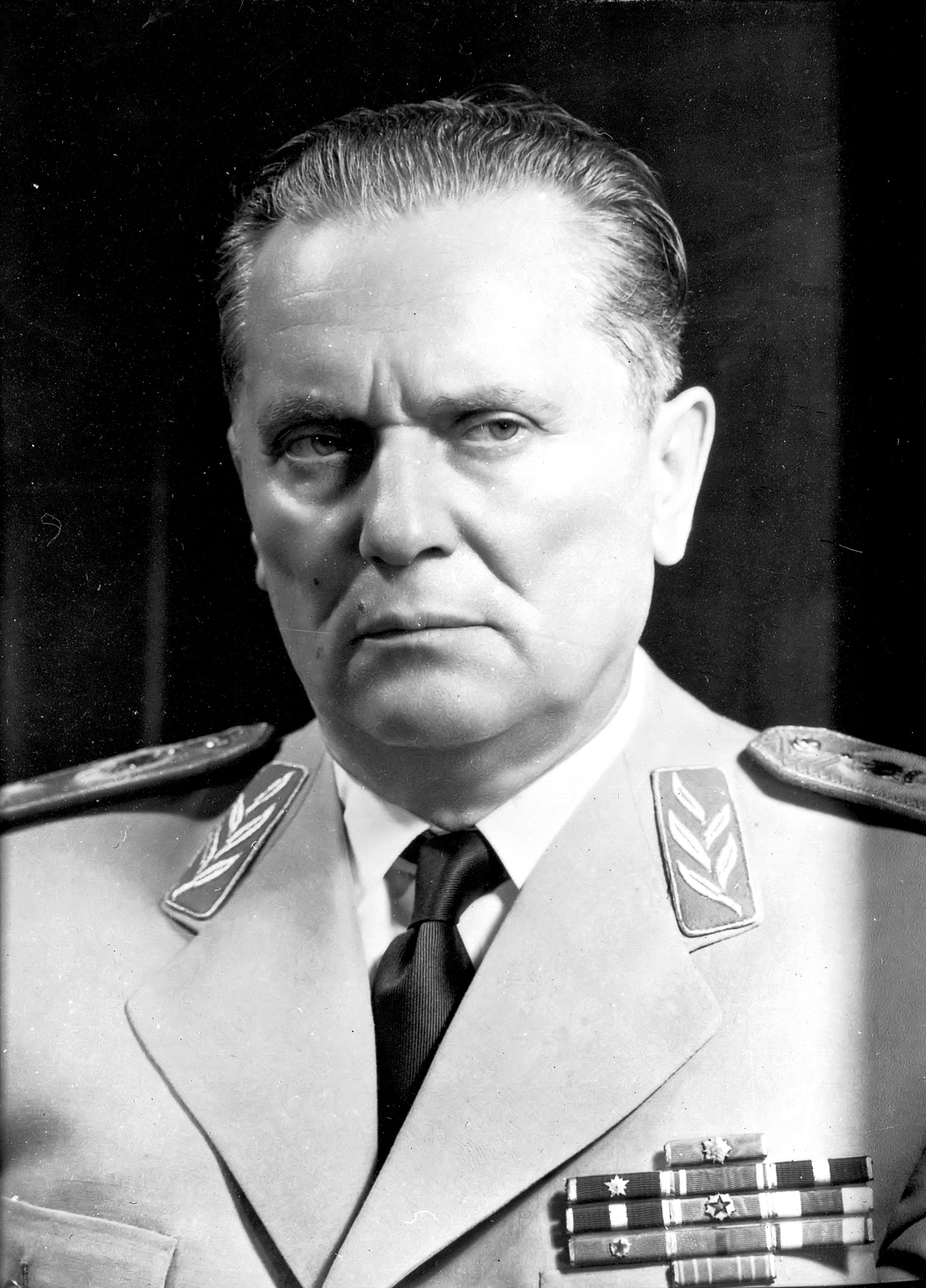 Josip Broz Tito, Public Domain, via Wikimedia
Josip Broz Tito, Public Domain, via Wikimedia
Then he called our attention to another landmark. “There,” he pointed to a mountainside where, as visible as the HOLLYWOOD sign, white rocks spelled the name TITO. Yugoslavia’s communist postwar president, Marshal Josip Broz Tito, held the warring Balkan states together with an iron fist. Karlo said some remember fondly the stability he brought. He died in 1980 and after the Iron Curtain fell in 1989 the countries began pulling apart.

Slovenia declared its independence on June 25, 1991. So did Croatia, but fighting had already started between Catholic Croatia and its Eastern Orthodox Serbian militias. By 1992 Serbian president Slobodan Milosevic had fanned the old religious hatreds into full scale war. Most of it bypassed Slovenia. Croatia and especially Bosnia and Herzegovina, largely Muslim, were not so lucky.
“We had two young children,” Karlo said. “There was no fighting where we were, but it scared us.”
He dropped us off first in Ljubljana. The three-star Urban Hotel, which we had booked online at Booking.com, was modern, un-fussy, and spacious. We took a revival nap and then went out to look around.
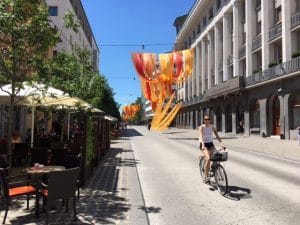
The hotel put us in a perfect spot. A short walk on Slovensak cesta took us to the post office, where we turned into the old city’s pedestrian zone and followed Copova ulica past clothing and book stores, kebab shops and restaurants to Preseren Square and Tromostovje.
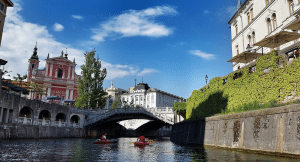
Here at the old city’s center, three stone bridges span the narrow meandering Ljubljanica River and connect the medieval town with its new sections.
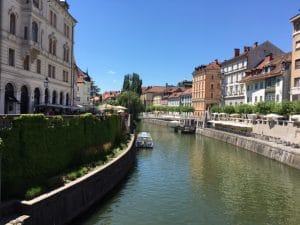
Architect Joze Plenik brilliantly understood that his art deco style bridges and pedestrian walkways on either side of the river would attract visitors and cause them to linger. And all around us, walkers took in the summer evening, dogs tugged at their leashes, bicyclers weaved among the crowds, and spectators gathered to watch an acrobatic troupe hoist a brave child three shoulders high above the pavement.
Ljubljana may have an old history, but most of the people in the streets seemed young, giving the place a current vibe with beards, tattoos, and blue hair in abundance.
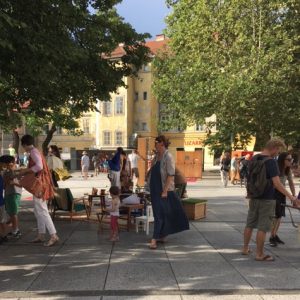
Restaurants, cafes and stalls selling ice cream lined both sides of the river. The menus of fish and sausage and grilled lamb seemed pretty similar
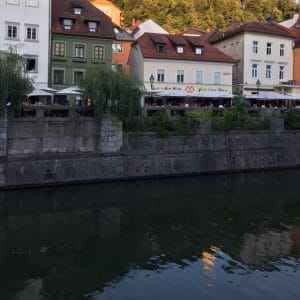
My friend Karen Kester had recommended a restaurant a block beyond the river. We strolled by to have a look, but the tables under umbrellas on the street were full. We wandered back to the river and a restaurant there.
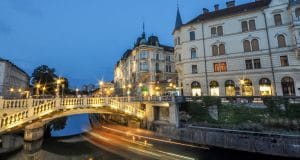
We ordered fried calamari and some prosciutto with olives, then split a main course of pan-fried trout, accompanied by Slovenian white wine.
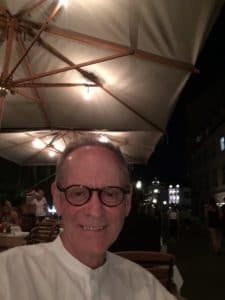 The Balkan climate makes for excellent wines, and every Balkan country produces their own varieties.
The Balkan climate makes for excellent wines, and every Balkan country produces their own varieties.
We walked back to the hotel the way we came and fell asleep before the Fourth of July fireworks started back home in the United States.
The next morning, after a good hotel breakfast,
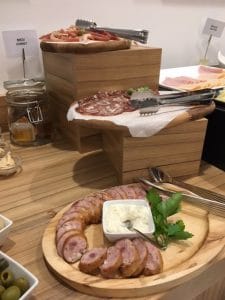
we walked a few blocks to the bus station and bought tickets to Bled, a lake town about 35 miles northwest of the city.
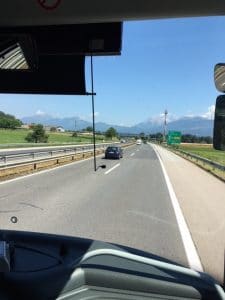
Barbara and I took seats at the front so we could get full view of the countryside.
As the bus rolled along the four-lane highway, it traveled into mountains where patches of trees struggled to cling to steep rock cliffs.
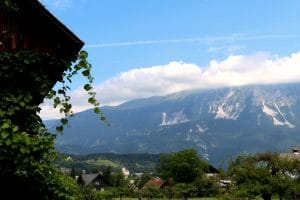
Bled itself seemed like it jumped out of a picture book. Tree-covered hillsides descended to its centerpiece, Lake Bled, a clear blue-green glacial lake.
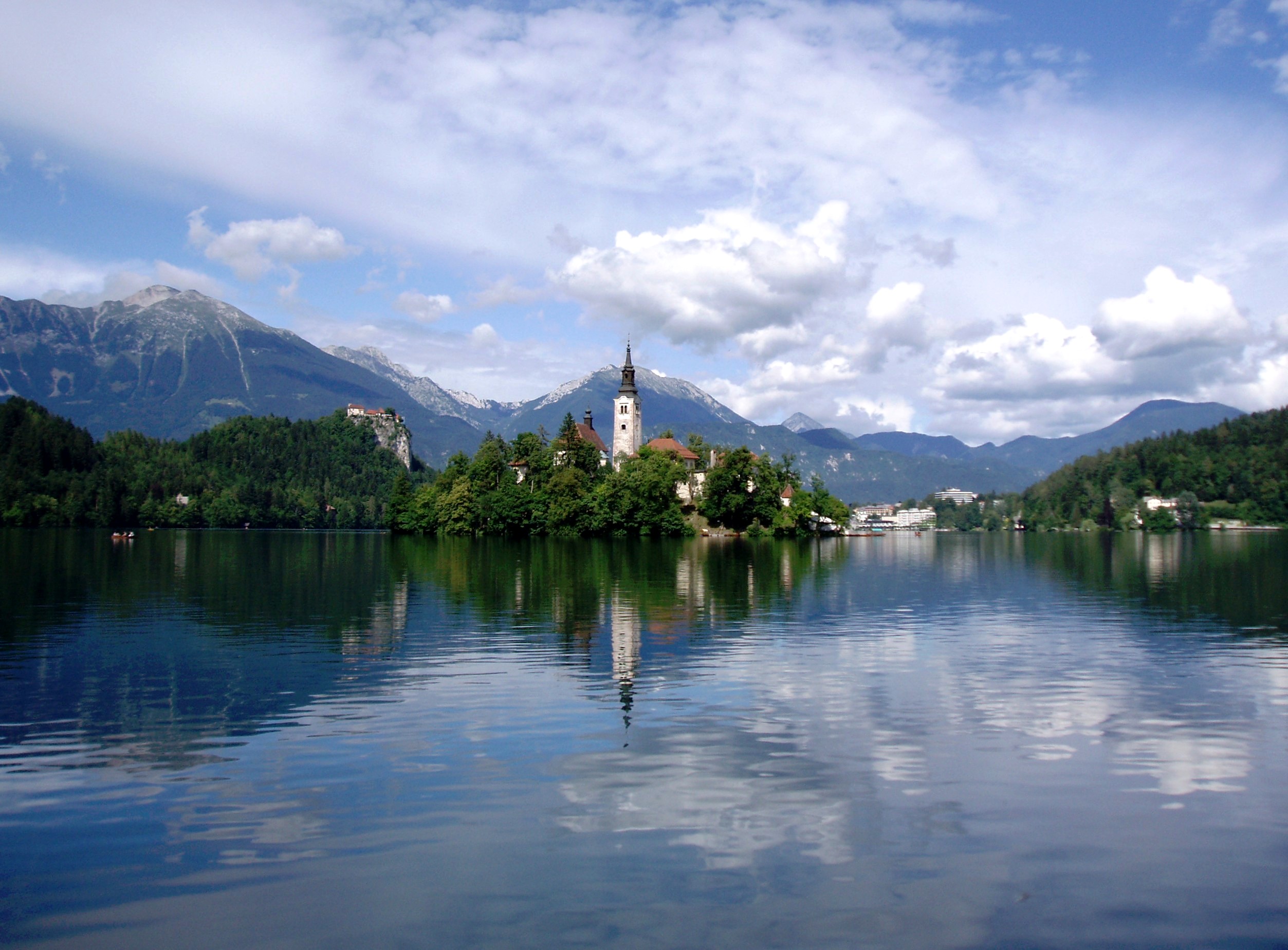
A medieval castle named, not surprisingly, Bled Castle, surmounts a sheer cliff that rises from one shore.

A 17th century church dominates the lake’s sole small island. A walking and bicycling path circles the lake, and the volume of tourists didn’t distract from its tranquillity and beauty.
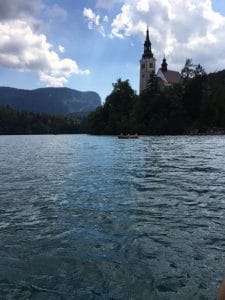
Our bus tickets included entrance to the castle, so we started our visit with the climb.
A steep switchback dirt path, interspersed with steps, took us up and up and up. We encountered more steps when we finally reached the top; our iPhones told us we’d climbed thirty stories. But it felt worth it because once we reached the castle walls the lake spread out below us.
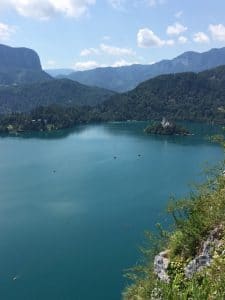
The Bled Castle museum told the region’s history from its Stone Age settlers through a period as an iron smelting center and, in the 19th century, as a health resort.
Returning down the steep path,
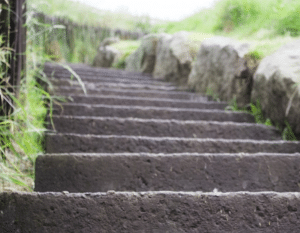
we fell in with a man wearing a ball cap and a navy shirt neatly tucked into navy shorts. Glyn Thomas, a chatty Welshman, told us he came to Bled to sing with his choir group. “A lot of Welsh like to sing in choruses,” he said. Turned out, he also played on Wales’ Over 70s field hockey team. At seventy-six, he was the goalie and served as the team captain. He proudly said, “We won the Over 70s bronze medal in Australia in 2016.”.
We left Glyn to rejoin his group and, back at lakeside, we ate a delicious lunch of local smoked fish
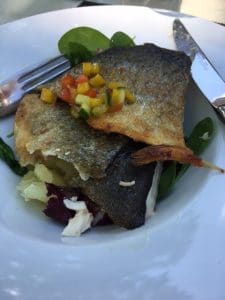
and watched people swimming and fishing. Then we headed to a point on the shore where you could take a Pletna boat to Bled Island. What is a Pletna boat? you ask.
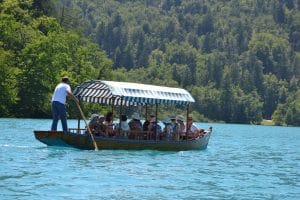
They’re unique to Lake Bled, used originally in the 16th century to ferry pilgrims to the island church
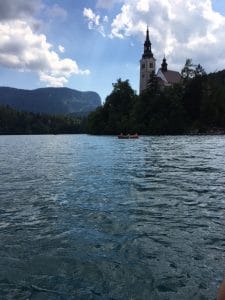
where we were headed, propelled by oarsmen wielding two oars. We boarded with a dozen others, though the awning-shaded boats can take up to twenty.
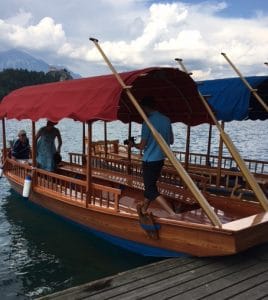
Our Pletnarstvo, as the oarsmen are called, plied his oars from the boat’s stern, leaning forward to begin each stroke. He steered us through long straight rows of buoys where rowers will compete in September in the World Rowing Masters Regatta. He docked at the island and we got off to look around.
A long stone set of stairs
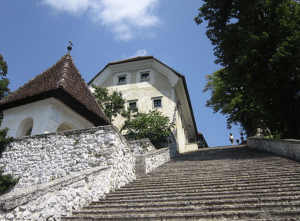
rises to the Pilgrimage Church of the Assumption of Maria, built on the site of a Slavic temple to a pagan love goddess.
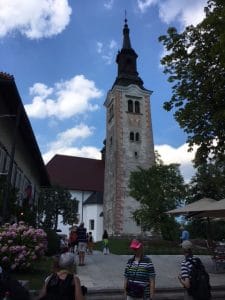
The church hosts a lot of weddings, and legend says the groom must carry the bride up the ninety-nine steps. A wedding reception was just ending and the pretty blonde bride posed with the groom for the last photos.
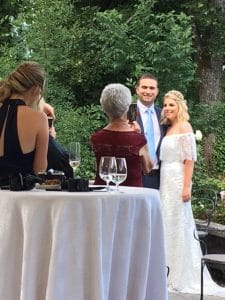
We descended a second set of steps to the opposite side of the island, followed the shoreline back to the docking point, and climbed aboard for the ride back.
To break the uneasy elevator silence, Barbara started talking to some of our fellow passengers, a couple from Pretoria, South Africa and a couple from Newcastle, England. The South Africans had just come to Bled from Zagreb, Croatia, our next stop. But rather than talk about travel the husband, named John, had a question for us: “Why on earth would Americans vote for Donald Trump. We have Jacob Zuma. But Trump?” He shook his head. “How did it happen?” The Newcastle couple seemed interested, and also perplexed.
We tried to explain the electoral college and the anger of Americans in the center of our country without jobs or good prospects. Then we asked the Brits if they had voted for Theresa May and Brexit. “Yes, we did,” the husband Arthur answered, and his wife shook her head in agreement. “The European Union is getting too big. They want too much money, and they have too much power.”
“But here you are in an EU country and you like to travel,” I said. ” “There is that,” Arthur replied. “But I follow my MP. She’s up on it all. And I voted with her.”
We would not solve isolationism versus globalism this afternoon, and the discussion gave Barbara and I more to think and talk about when the Pletna boat delivered us to shore.
On the bus back to Ljubljana dinner plans began to percolate.
My friend Karen had recommended another Ljubljana restaurant, Spajza, across the river at the far edge of the old town. We took a taxi and sat down in a back garden with ivy-covered walls.
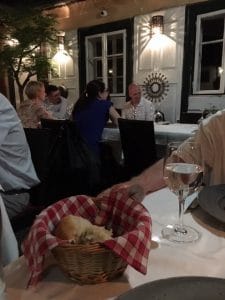
The waiter brought us a complimentary amuse bouche of shredded horse cheek with shaved parmesan to go with our prosecco.
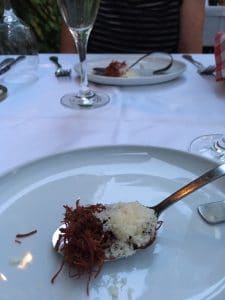
Horse – young horse, actually – joined items more commonly found on American menus. You could order young horse carpaccio with ricotta as a cold appetizer, or main course fillets of young horse with truffles or boletus mushrooms. You could also, as I did, order smoked goose breast to start
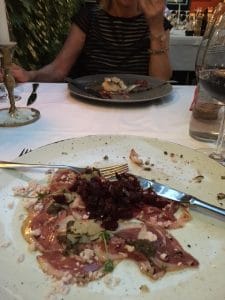
and roast wild boar cheeks as a main. Barbara had the horse fillet and we shared a bottle of Slovenian wine.
Our fifteen-minute walk back to the hotel took us along the river and through the lively street and restaurant scene we found the night before.
At breakfast the next morning we talked about how we’d get to Zagreb. We’d enjoyed the bus ride to Bled and we thought about getting to Zagreb the same way. Tickets were cheap, ten euros or less, and buses left often. The train — our original plan — left in mid-afternoon. Both rides took a little over two hours.
But Amadea, one of the fine staffers at the Urban Hotel, advised against the bus. “Oh no,” she said. “You don’t want to do that. You’ll wait for hours in line at the border.”
This was another story about a Balkans conflict over territory. Croatia, with 1,100 miles of coastline on the Adriatic Sea, wants to bigfoot Slovenia and take its twenty-six miles of coast and the fishing rights that go with them. An international mediator ruled in favor of Slovenia. But Croatia won’t abide by the ruling. So it makes border crossings at most points between the two countries difficult.
We bought tickets for eight euros apiece on the 2:45 train to Zagreb.
That gave us the morning to explore, via a funicular ride, Ljubljana Castle on the hill that dominates the city.
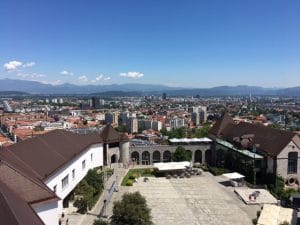
The castle has been around in some form since the Romans built a fortress there 1,000 years ago. Under other rulers it became an arsenal, an army barracks, a military hospital and Napoleon, in the 19th century, made it a prison.
Today, restored, the castle houses a museum, which includes photos of Italian prisoners of war captured in the region we drove through. From the upper walls it allowed great views of the city’s red-tiled roofs and the mountains beyond.
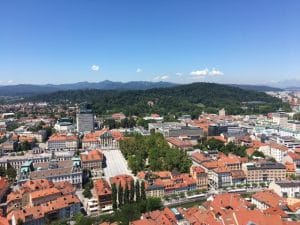
We rode the funicular back down to street level and had just enough time to stop at Sokol, the first restaurant Karen had recommended as “very old and traditionally Slovene.”
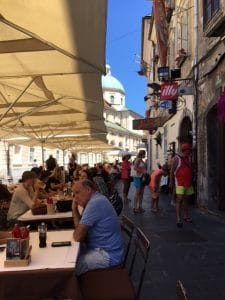
We didn’t opt for heavy Slovene fare. We did have an octopus salad at one of its tables on the street. And then we headed to the train station.
We took the facing window seats in one of the six-seat compartments and settled down for the ride. Four men with their work gear slipped into the compartment with us and one wore a T-shirt from Hampton Bays, NY. “Have you ever been to Hampton Bays?” I asked. He laughed and said he hadn’t. But that got the conversation rolling.
Blaz and his buddies worked on the railroad repairing tracks and began and ended their day in Ljubljana. His friends got off at the first stop, and Blaz continued on. We talked about the coastal dispute with Croatia and he said, “They should get rid of all the politicians. The people have no problems. It’s the politicians that make the trouble.” Blaz said goodbye two stops later.
On one of the last stops inside Slovenia, an attractive young backpack-toting couple joined us.
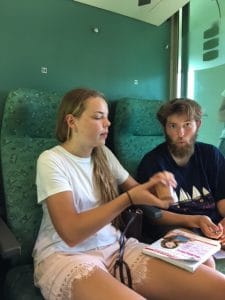
At first they took out a pair of dice to play a game. We kept reading. But after we shared few curious surreptitious glances, they introduced themselves as Stine and Jackob from Denmark’s Jutland peninsula. They had just graduated from high school and planned to spend a year working before they went on to higher education. He had job in a fulfillment center warehouse, “I don’t plan to be there forever,” he said. She worked in eldercare. They had been in Austria, but dipped down into Slovenia so that they could say they’d been there. They planned to wrap up their trip in Zagreb.
They wanted to know how Americans could elect Donald Trump president. We tried to explain and maybe because they were young, they seemed really interested in the complexities of our electoral college system and the anger of Americans who could believe in someone as phony as Donald Trump.
The train stopped at the border crossing between Dobova, Slovenia, and Savski Marof, Croatia. First a Slovenian police officer checked our passports, and then a Croatian officer followed her. It took less than fifteen minutes and proved that Amadea from the Urban Hotel was right when she advised us to take the train rather than a bus. We would later learn for ourselves about the tedious Balkan border crossings.
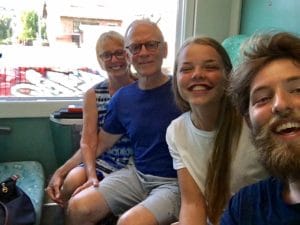
On the outskirts of Zagreb we took selfies with Jakob and Stine and then watched the city come into view as the train lumbered into the station.
![]() Read the next part here
Read the next part here
